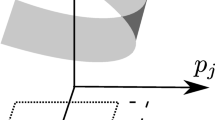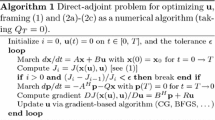Abstract
The solution to a completely hypersensitive optimal control problem may shadow trajectories on the stable and unstable manifolds of an equilibrium point in the state–costate phase space. If such shadowing occurs, the solution of the Hamiltonian boundary value problem, that constitutes the first-order necessary conditions for optimality, can be approximated as a composite of an initial segment on the stable manifold leading to the equilibrium point and a final segment on the unstable manifold departing from the equilibrium point. Using a dichotomic basis, the Hamiltonian vector field can be decomposed into stable and unstable components, and the unspecified boundary conditions for the initial and terminal segments can be determined such that the initial and final conditions are, respectively, on the stable and unstable manifolds of the equilibrium point. In this paper, we propose and justify the use of finite-time Lyapunov vectors to construct an approximate dichotomic basis and develop a corresponding manifold-following solution approximation method. The method is illustrated on two examples and shown to be more accurate than a similar method that uses eigenvectors of the frozen-time linearized dynamics.











Similar content being viewed by others
Notes
Lam, S.H.: Personal communication, Princeton University, Princeton, NJ (1990)
References
Bryson, A.E., Ho, Y.-C.: Applied Optimal Control: Optimization, Estimation, and Control. Taylor & Francis, New York, NY (1975). revised-printing
Rao, A.V., Mease, K.D.: Dichotomic basis approach to solving hyper-sensitive optimal control problems. Automatica 35, 3633–3642 (1999)
Rao, A.V., Mease, K.D.: Eigenvector approximate dichotomic basis method for solving hyper-sensitive optimal control problems. Opt. Control Appl. Methods 21, 1–19 (2000)
Oberle, H.J., Grimm, W.: BNDSCO—a program for the numerical solution of optimal controlproblems. Internal Report No. 515–89/22, Institute for Flight SystemsDynamics, DLR, Oberpfaffenhofen, Germany (1989)
Ascher, U.M., Mattheij, R.M., Russell, R.D.: Numerical Solution of Boundary Value Problems for Ordinary Differential Equations. SIAM Press, Philadelphia (1995)
Wilde, R.R., Kokotovic, P.K.: A dichotomy in linear control theory. IEEE Trans. Autom. Control 17, 382–383 (1972)
Anderson, B.O., Kokotovic, P.K.: Optimal control problems over large time intervals. Automatica 23, 355–363 (1972)
Chow, J.H.: A class of singularly perturbed nonlinear, fixed end-point control problems. J. Opt. Theory Appl. 29, 231–251 (1979)
Kokotovic, P.V., Khalil, H.K., O’Reilly, J.: Singular Perturbation Methods in Control: Analysis and Design. Academic Press, New York (1986)
Fenichel, N.: Geometric singular perturbation theory for ordinary differential equations. J. Differ. Equ. 31, 53–98 (1979)
Sacker, R.J., Sell, G.R.: The spectrum of an invariant submanifold. J. Differ. Equ. 38, 135–160 (1980)
Barreira, L., Pesin, Ya B.: Lyapunov Exponents and Smooth Ergodic Theory. American Mathematical Society, Providence (2002)
Lyapunov, A.M.: The general problem of stability of motion. Int. J. Control 55, 531–773 (1992)
Mease, K.D., Bharadwaj, S., Iravanchy, S.: Timescale analysis for nonlinear dynamical systems. J. Guid. Control Dyn. 26(1), 318–330 (2003)
Mease, K.D., Topcu, U., Aykutlug, E., Maggia, M.: Characterizing two-timescale nonlinear dynamics using finite-time Lyapunov exponents and subspaces. Commun. Nonlinear Sci. Numer. Simul. 36, 148–174 (2016)
Danforth, C.M., Kalnay, E.: Using singular value decomposition to parametrize state-dependent model errors. J. Atmos. Sci. 65(4), 1467–1478 (2008)
Danforth, C.M., Yorke, J.A.: Making forecasts for chaotic physical processes. Phys. Rev. Lett. 96, 144102 (2006)
Hartmann, D.L., Buizza, R., Palmer, T.N.: Finite-time instabilities of lower-stratospheric flow. J. Atmos. Sci. 53(15), 2129–2143 (1996)
Kalnay, E.: Atmospheric Modeling, Data Assimilation and Predictability. Cambridge University Press, Cambridge (2003)
Haller, G.: Distinguished material surfaces and coherent structures in three-dimensional fluid flows. Phys. D 149, 248–277 (2001)
Haller, G.: A variational theory of hyperbolic Lagrangian coherent structures. Phys. D 240, 574–598 (2011)
Lekien, F., Shadden, S.C., Marsden, J.E.: Lagrangian coherent structures in n-dimensional systems. J. Math. Phys. 48, 065404 (2007)
Shadden, S.C., Lekien, F., Marsden, J.E.: Definition and properties of Lagrangian coherent structures from finite-time Lyapunov exponents in two-dimensional aperiodic flows. Phys. D 212, 271–304 (2005)
Wolfe, C.L., Samelson, R.M.: An efficient method for recovering Lyapunov vectors from singular vectors. Tellus 59A, 355–366 (2007)
Adrover, A., Creta, F., Giona, M., Valorani, M.: Biorthogonalization, geometric invariant properties and rate-based estimate of Lyapunov spectra. Phys. Lett. A 342, 421–429 (2005)
Adrover, A., Creta, F., Valorani, M., Vitacolonna, V.: Natural tangent dynamics with recurrent biorthonormalizations: a geometric computational approach to dynamical systems exhibiting slow manifolds and periodic/chaotic limit sets. Phys. D 213, 121–146 (2006)
Guckenhheimer, J., Kuehn, C.: Computing slow manifolds of saddle type. SIAM J. Appl. Dyn. Syst. 8(3), 854–879 (2009)
Osinga, H.M., Tsaneva-Atanasova, K.T.: Geometric analysis of transient bursts. Chaos 23, 046107 (2013)
Fleming, W.H., Rishel, R.W.: Deterministic and Stochastic Optimal Control. Springer, New York (1975)
Patterson, M.A., Rao, A.V.: GPOPS-II: a MATLAB software for solving multiple-phase optimal control problems using hp-adaptive gaussian quadrature collocation methods and sparse nonlinear programming. ACM Trans. Math. Softw. 41(1), 1–37 (2014)
Arnol’d, V.I.: Ordinary Differential Equations. Springer, Berlin (1992)
Kelly, H.J.: Aircraft maneuver optimization by reduced-order approximations. In: Leondes, C.T. (ed.) Control and Dynamic Systems. Academic Press, New York (1973)
Aykutlug, E., Maggia, M., Mease, K.D.: Solving partially hyper-sensitive optimal control problems using manifold structure. In: 9th IFAC Symposium on Nonlinear Control Systems (NOLCOS 2013), Nonlinear Control Systems, vol. 9, Part 1, pp. 187–192. Toulouse, France. International Federation of Automatic Control (2013)
Dieci, L., Van Vleck, E.S.: Lyapunov spectral intervals: theory and computation. J. Numer. Anal. 40(5), 516–542 (2002)
Goldhirsch, I., Sulem, P.L., Orszag, S.A.: Stability and Lyapunov stability of dynamical systems: a differential approach and a numerical method. Phys. D 27(3), 311–337 (1987)
Golub, G.H., Van Loan, C.F.: Matrix Computations, 3rd edn. The Johns Hopkins University Press, Baltimore (1996)
Doerner, R., Hubinger, B., Martienssen, W., Grossmann, S., Thomae, S.: Stable manifolds and predictability of dynamical systems. Chaos Solitons Fractals 10(11), 1759–1782 (1999)
Vastano, J.A., Moser, R.D.: Short-time Lyapunov exponent analysis and the transition to chaos in Taylor–Couette flow. J. Fluid Mech. 233, 83–118 (1991)
Topcu, U., Mease, K.D.: Using Lyapunov vectors and dichotomy to solve hyper-sensitive optimal control problems. In: Proceedings of the 45th IEEE Conference on Decision and Control, San Diego, CA, USA (2006)
Acknowledgments
This work was supported by the National Science Foundation under Grants CMMI-0010085 and CMMI-1069331.
Author information
Authors and Affiliations
Corresponding author
Rights and permissions
About this article
Cite this article
Aykutlug, E., Topcu, U. & Mease, K.D. Manifold-Following Approximate Solution of Completely Hypersensitive Optimal Control Problems. J Optim Theory Appl 170, 220–242 (2016). https://doi.org/10.1007/s10957-016-0868-3
Received:
Accepted:
Published:
Issue Date:
DOI: https://doi.org/10.1007/s10957-016-0868-3




